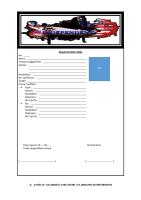- Test
Test
is an instrument or activity used to accumulate data on a person’s ability to
perform a specified task. In kinesiology the content of these tests are usually
either cognitive, skill, or fitness. Test is also a method to determine a student's ability to complete
certain tasks or demonstrate mastery of a skill or knowledge of content. Some
types would be multiple choice tests, or a weekly spelling test. While it
is commonly used interchangeably with assessment, or even evaluation,
it can be distinguished by the fact that a test is one form of an assessment.
Data: The translation of behavior into a numerical or verbal descriptor which is then recorded in written form. Use of test
Use
of test
·
Motivation
·
Achievement
·
Improvement
·
Diagnosis
·
Prescription
·
Grading
·
Classification
·
Prediction
2. Measurement
The process of
obtaining a numerical description of the degree to which an individual
possesses a particular characteristic. Measurement answers the question, “How
much?”.
·
Test is used to gather information.
·
That information is presented in the
form of measurement.
·
That measurement is then used to make
evaluation.
A
measurement takes place when a “test” is given and a “score” is obtained. If
the test collects quantitative data, the score is a number. If the test
collects qualitative data, the score may be a phrase or word such as
“excellent.”
Types
of Measurement
a. Quantitative
·
time
in one mile run
·
score
on basketball spot shooting test
·
grade
on weight training exam
b. Qualitative
·
“excellent”
ranking on throwing form
·
checklist
on golf swing
·
score
on gymnastics routine
Measurement Process Involves Four
Steps, like :
1.
Define
the characteristics that you want to measure.
2.
Select
the appropriate test. This may also mean to select the appropriate testing
instrument.
3.
Administer
the test. If an instrument is involved in the testing, this also means to use
the instrument correctly.
4.
Collect
and record the measurement from the test.
2. Evaluation
Definition
1 : The process of making judgments
about the results of measurement in terms of the purpose of the measurement.
Definition
2 : The process of obtaining
information (data) and using it to form judgments, which in turn are used in
decision making.
Steps
Involved in Making an Evaluation
1.
Define
the objective or the purpose of the test.
2.
Measure
the performance or administer the test.
3.
Find
or develop a standard.
4.
Compare
a person’s performance on the test to a standard.
5.
Make
the evaluation then discuss and distribute the results in the most appropriate
manner.
Formative
& Summative Evaluation
Ø Formative evaluation : If the
evaluation is at the beginning or during.
Ø Summative evaluation : If the
evaluation is at the end.
Concept of Evaluation
·
Science of providing information for
decision making.
·
Includes measurement, assessment and
testing
·
Information gathering
·
Information processing
·
Judgement forming
·
Decision making
Norms
Evaluations
are often based on norms:
ü Local norm: Norms based on a relatively
small group of subjects. Ex: Pull-up norms for 7th grade boys at one
school.
ü State norms: Norms that are
representative of all similar subjects in the state. Ex: CAHPERD fitness norms
for 7th grade boys.
ü National norms: Norms that are
representative of all similar subjects in the United States. Ex: AAHPERD
fitness norms for 7th grade girls.
Reliability
v Reliability defined as the consistency
of an individual when repeatedly performing the same test.
v Example: If a group of people take the
same test on two different days, the scores obtained should be approximately
the same.
v A reliable test will yield data that are
stable, repeatable, and precise. Reliability of a test refers to the
dependability of test scores.
Validity
n The American Psychological Association
(APA) reported that validity is the most important characteristic to a test or
measuring instrument.
n The validity of each test can only be
evaluated in terms of a particular purpose and for a particular group.
n Example: A strength test that is valid
for college-aged students is not necessarily valid for sedentary adults.






0 comments:
Post a Comment